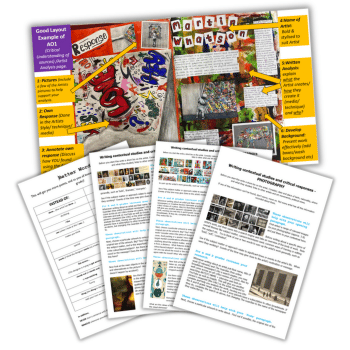These five art GCSE final piece resources will support students to create an impressive project.
- FINE ART – Guidance on how to write effective contextual studies and critical responses to examples of fine art.
- ANALYSIS – A PowerPoint of good and excellent examples of AO1 critical understanding / artist analysis pages.
- GRAPHICS – Advice on how to present successful contextual studies and critical responses to examples of illustration and graphic design.
- PHOTOGRAPHY – Suggestions on what’s required to produce contextual studies and critical responses to photography, in a way that satisfies the GCSE art assessment criteria.
- BETTER WORDS – A list of suggested alternative words that will get students more points (eg ‘create/develop/produce’ instead of ‘do/doing’
GCSE art final piece advice for teachers
As art teachers, we’re all familiar with the arc of a project. More often than not, we start with artist research and finish with an artwork, or collection of pieces that show the student’s journey from initial investigation to a personal conclusion.
With these two elements regularly bookending a project, then, the pressure on them to hold the work together is paramount. Here are some ideas to make sure they do just that.
First, let’s get rid of the idea that students always need to look at ‘artists’. Yes, they normally do (it makes sense), but I prefer to use the term ‘influences’. For us, this switch in language led to a new openness in seeing how varied artistic traditions, not at first obviously related, could inform one another.
British artist Polly Morgan points out the need to not ‘restrict yourself to your own medium’. It’s just as possible to be inspired by a filmmaker, fashion designer, writer or friend than another artist.”
Her contemporary, Isaac Julien, has much the same idea: “I have a magpie attitude to inspiration. It’s about taking all the little everyday things and observing them with a critical eye; building up a scrapbook which you can draw on.”
To help our students develop an understanding of breadth, we have a 10-point independent learning list, into which we encourage them to dip each week. This may or may not feed back directly into their work, but helps them develop a much more rounded understanding of the arts.
GCSE art form and structure
Next, let’s consider structure. It’s important to understand that we’re not here to create historical documents. Biographical information is useful only if it informs our understanding.
For example, we don’t need to know how many children a person had, but we may want to know what their relationships were like if their work is directly related to the experience of family life. Added to that, the cost of artwork is irrelevant.
The fact that someone may have paid several millions for a piece is not an indicator of its value – not in artistic or cultural terms, anyway.
Each artist has a range of interests, experiences and perspectives. From this, we want to know the aim of their art practice. Let’s take for example Käthe Kollwitz, a German, born in Kaliningrad, who lived from 1867 to 1945. These are useful facts. They tell us she lived in a place and time when the world was at war.
Her city of birth was a strange geographical example of detachment; a part of Russia, separated from its motherland by Poland and Lithuania. As such, we can guess she was interested in the effects of war and in belonging. But can we find evidence?
Here is where quotes from the artist can be helpful. The MoMA website starts its section on Kollwitz with her quote “I felt that I have no right to withdraw from the responsibility of being an advocate. It is my duty to voice the sufferings of men.”
So now we know where and when she lived. We know what was happening socially and politically at the time, and that her aim for her work was to make clear the suffering experienced.
GCSE art themes
Research undertaken, let’s now start to observe. Here is where the formal elements come in.
Look at her colours, use of line, compositions. Do they, as she lays out they should, tell of man’s suffering? Do students believe she has achieved what she set out to do? Why? Is it through her use of visual isolation, the individual surrounded by the white space of the paper?
Perhaps the fracturedness with which she used a pencil; the intense focus on the human face?
Linking facts, quotes and observations steeped in an understanding of the formal elements is needed to ensure a written piece has the depth required to show true engagement with the work.
This understanding becomes the diving board for the student’s own work. Once they know ‘what’, ‘how’ and ‘why’, they can apply this to their own piece.
What causes them anguish? What do they want to portray so others can see? Have they thought about what marks they will make to convey the urgency they feel?
This is why we research: not to copy, but to give ourselves an understanding and language for our own artwork’s aims.
In fact, the assessment objectives do not state that all research must be written. Any real investigation of an influence must be deeply practical, too. In order for students to develop ideas through investigation or show an understanding of critical sources, their creative response is central.
Sketchbook ideas
Yes, AO1 focuses on research, but this research should permeate all the way through to A04.
A GCSE art final piece on its own is worth nothing. It might feel like the Big Daddy; but we all know that the bulk of the marks come from AO1-3, and that unless the outcome sits firmly within the preceding investigations, it has little value.
The art assessment criteria asks for a ‘purposeful and meaningful response’. In order for any pieces that come at the end to achieve this, they must be a response to the work in the sketchbook, showing development from initial ideas, and a refinement of both thought and practice.
One of the challenges I face is when students propose a GCSE art final piece, rather than an area of investigation right from the start. So, in order to keep projects open – to ensure experimentation and exploration is genuine – we remove any specific final piece planning.
Instead, we focus on an arena of interest, laying down specifics only when initial investigative and experimental work is complete.
Evidence
In reality, the only difference between the GCSE art final piece and the rest of the submission is how it consolidates the journey. The body of work that precedes it is there to help students find interesting connections and surprising new pathways that can then be narrowed down. Any particular approaches used in a final piece need to be evidenced in that preceding work.
I will end with this: that while I believe, as do those I have spoken to, that exam boards and moderators have favourite styles or types of outcomes, the student’s strengths and interests must win out.
When I was once asked at interview to name a favourite artist, my answer was simple – that it didn’t matter. It was finding the creative influences that were right for the students that should be my aim.
I stand by that, and hope that all art teachers would, too.
Writing checklist
Five pointers for better-written analysis…
- Remove any biographical information that’s not relevant.
- Watch out for commonly used weak words and provide students with alternatives. The ‘Better Words’ sheet at the top of this page can help you get started.
- Find quotes from respected art critics. Include them and explain what they mean. Many media outlines charge for their online content, but The Guardian and the BBC’s arts coverage can be accessed for free.
- Make sure students explain any tricky terminology they use and any key ideas for art movements they mention.
- Consider adjusting writing guides for different art practices. Some points of focus will vary according to the medium.
Hannah Day is head of art, media and film at Ludlow College. Lucy Wilding is head of art at Lacon Child School, Shropshire. Download a free GCSE art sketchbook resource.










